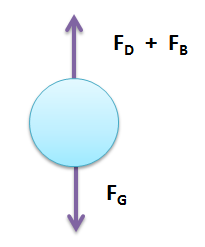Gravity Settling Separation
This article illustrates determination of terminal velocity required for gravity separation. Performing a force balance on liquid droplet settling out of gas stream results in following relationship.

where FB is force due to Buoyancy, FD is force due to Drag and FG is force due to gravity.
FG = m.gFB = m.ρV.g/ρLFD = CD.(ρV.Vt²/2).AP
Assuming spherical liquid droplet with diameter DP, above equation gets reduced to
FD = FG - FBFD = CD.(ρV.Vt²/2).(π.DP²/4)FG - FB = m.g(ρL - ρV)/ρLm = 4/3.(π.DP³/8).ρL
Balancing above equation gives following relation for terminal velocity Vt.
Vt = [(4gDP/ 3CD).(ρL - ρV)/ρV ]0.5Drag coefficient depends on shape of particle and Reynold's number and can be determined from below graph.

Above curve can be simplified into 3 sections resulting into 3 settling laws.
Stoke's Law
At low Reynold's number < 2, a linear relationship exists between CD and Re.
CD = 24/ReRe = DP.ρV.Vt/μVVt = g.DP².(ρL - ρV)/18μV
In English units, with DP in feet, Vt in feet/sec, ρ in lb/ft³, g = 32.2 feet/sec² and μ in centipoise, above equation can be expressed as.
Vt = 1488.g.DP².(ρL - ρV)/18μVCriterion K is defined to determine the flow regime as following.
K = DP[g.ρV(ρL - ρV)/μV²]1/3Value of K is evaluated for Reynold's number 2 based on Stoke's Law.
Re = 2Vt = 2.μV/(ρV.DP)K = (36)1/3K = 3.3
For K < 3.3 Stoke's Law is applicable.
Intermediate Law
For 2 < Re < 500, Intermediate law applies.
CD = 18.5/Re0.6Vt = 0.153 g 0.71 DP 1.14 (ρL - ρV)0.71/ ( ρV0.29. μV0.43)
In English units, with viscosity in centipoise, above equation can be expressed as
Vt = 3.49 g 0.71 DP 1.14 (ρL - ρV)0.71/ ( ρV0.29. μV0.43)Newton's Law
Newton's law is applicable for Reynold's number in range of 500 to 200,000.
CD = 0.44Vt = 1.74 (g.DP(ρL - ρV)/ ρV)0.5
Value of K is evaluated for Reynold's number 500 based on Newton's Law.
Re = 500K = (500/1.74)2/3K = 43.5
For K in the range of 3.3 to 43.5, Intermediate Law is applicable; for K > 43.5, Newton's Law is applied.
Stoke's Law is applicable for vapor separation from a continuous liquid phase and dispersed liquid separation from a continuous liquid phase. Intermediate Law is typically used for liquid separation from a continuous vapor phase.
Example
Calculate diameter for a vertical vapor liquid separator based on gravity separation. Gas flowrate is 50,000 lb/h, density is 3.7 lb/ft³ and viscosity is 0.01 cP. Liquid flowrate is 12,000 lb/h, density is 51.5 lb/ft³ and viscosity is 0.42 cP. Assume liquid particle diameter DPL as 250 micron and vapor particle diameter DPV as 150 micron.
Terminal velocity is to be calculated for gravity settling of liquid droplet from vapor phase. K Value is calculated to determine the applicable flow regime.
K = 41.1Intermediate Law is applicable for this case. Terminal velocity is calculated based on Intermediate Law.
Vt = 0.96 feet/secMargin of 75% is taken on terminal velocity and vessel diameter is calculated.
D1 = 2.58 feetA second terminal velocity is calculated for disentraining vapor from liquid phase. Typically Stoke's law is applicable for vapor disentrainment. Terminal velocity is calculated based on Stoke's law.
Vt = 0.07 feet/secWith margin of 75% on terminal velocity, vessel diameter is calculated.
D2 = 1.22 feetComparing both diameter values, highest value of 2.58 feet is selected as a minimum diameter required for gravity separation of vapor and liquid.
Resources